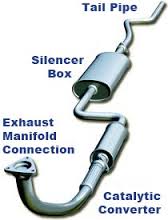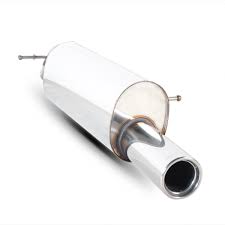Slung away underneath your car (unless you have a “68 Chevy with pipes on the side” as ageing rockers Saxon would say) your exhaust has to take punishment both from inside and outside, as it channels hot noxious gases away from your engine whilst being battered by spray, grit and mud thrown up from the road.

It also has to remove pollutants from exhaust gases, minimise noise (you only have to hear an unmuffled motorbike to past to realise how noisy cars would be without silencers) and provide “back pressure” to improve engine performance.
So yes it’s more complicated than just a hollow metal tube. An exhaust which has failed or become damaged can allow fumes and carbon monoxide to be drawn into the cabin, which can cause the driver to feel drowsy – an unwanted risk to everyone in the car.
Exhaust Components
Fortunately exhausts are designed in sections and a problem at any point can be isolated and that one section replaced. The various component sections are:
1. Manifold
The exhaust manifold is attached to the engine block and takes the exhaust gases directly away from each cylinder, funnelling them into the start of the single exhaust pipe. Sometimes the gaskets between the manifold and the engine block can fail, or the manifold itself can become cracked. This will cause loss of performance, unusual noises when the engine is running, and a strong smell in the engine bay.
2. Catalytic Converter
The job of the catalytic converter is to minimise pollutants in the exhaust gas from being output from the vehicle into the environment. Symptoms of damage here include:
- Poor performance
- Bad eggs smell
- Very dark exhaust smoke
- Reduced mpg
- MOT failure due to emissions
3. Centre Pipe
The job of the centre pipe of your exhaust is to reduce noise as much as possible (by reducing the pressure) without restricting the gas flow through the system.
The rear box provides further silencing. It is usually the part which will need replacing first as it is furthest away from the engine and most likely to be affected most by acidic moisture. As it is the part furthest from the engine it remains cold which gives the gases a chance to condense and form pools within the section.
5. Tail Pipe
The tail pipe vents the remaining gas and is often styled to look cool and groovy at the back of the car. I think we’ve all seen the Vauxhall Nova 1.0’s driving around Essex with fake “twin-exhausts” from Halfords stuck on the back!
Another device that works along side the exhaust system is the oxygen sensor which we look at here.
Exhaust Problems
Most exhaust problems are caused by corrosion; this happens more quickly on vehicles which are used for short journeys since water vapour can collect in the silencer and causes rapid rusting from the inside.
A problem with your exhaust will usually be detected by the increased noise when driving, particularly when accelerating.
Also look out for any items which look like they are hanging from the car, sometimes brackets and fixtures can become loose and it is easier and cheaper to replace them as soon as possible rather than leaving them as they may cause part of the system to fail. I remember having to tie the exhaust of my first car – a 1975 Datsun Cherry – to the remains of a rusted-through exhaust bracket with washing line until I could get it to the garage. Happy days!


